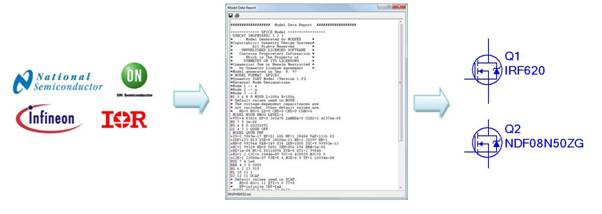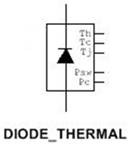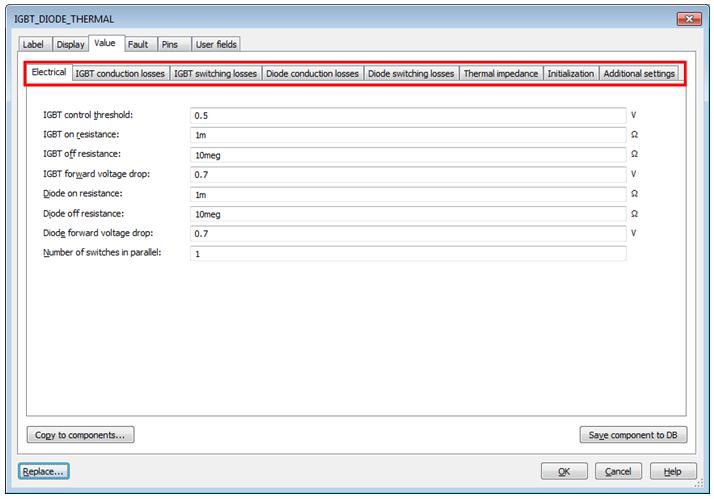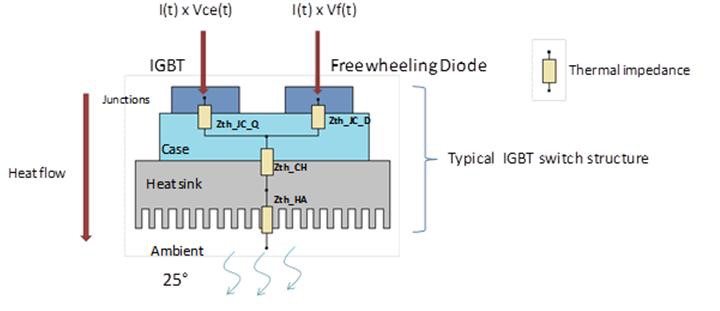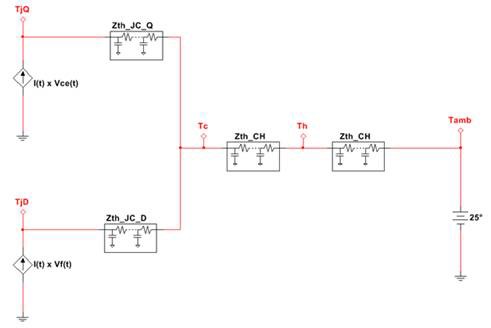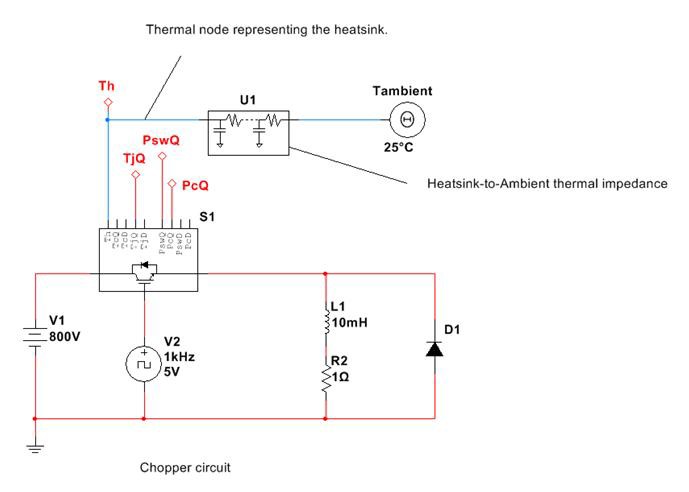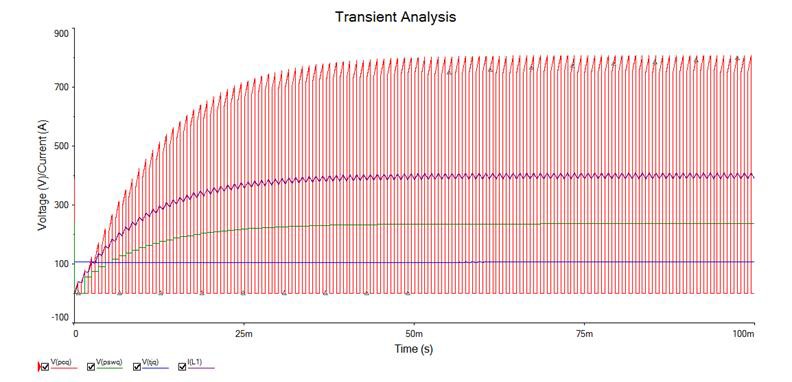Understand the Thermal Effects of Power Electronics
Overview
Contents
- Thermal Power Components
- Customize the Generic Models
- Thermal Analysis Overview
- Example Thermal Analysis with the IGBT_DIODE_THERMAL
Thermal Power Components
Power electronics systems are becoming increasingly complex and demand advance modeling of behaviour such as non-linearity’s, switching losses, and thermal behaviour. The Multisim library includes a variety of models for MOSFET and IGBT switches from leading manufactures such as NXP, International Rectifier and Texas Instruments allowing students to simulate the same industry components used in the laboratory. These models are supplied by the manufacturer and are verified by themselves and NI to ensure accuracy. NI forges strong relationships with these partners to ensure a constantly evolving database of components. Multisim also has over 500 new Infineon MOSFETS, with up to 3 levels of model complexity for intricate power applications such as thermal modelling. These are suited to both senior and master’s level power courses where students must gain extensive knowledge analyzing, exploring and designing complex power switching control systems.
Since Multisim 13.0 customizable models for diodes, IGBTs, and MOSFET components have been included specifically for modelling thermal behaviour. These components allow you to accurately determine switch-mode-power-supply (SMPS) thermal behaviour. These devices allow students to explore the thermal effects of power electronic circuits using ideal electrical models. For electrical simulation Multisim has other power component models more suited to electrical simulation details of which can be found in this Power Components white paper.
Generic thermal component models are typically used as part of master’s level power engineering courses where the thermal effect of these components is investigated.
These devices are available in the Multisim library in the following location:
Database: Master Database
Group: Power
Family: Switches
Component: DIODE_THERMAL, IGBT_DIODE_THERMAL, MOSFET_DIODE_THERMAL
Thermal IGBT (IGBT_DIODE_THERMAL)
This model represents a power switch that includes an IGBT (insulated gate bipolar transistor) device and a diode device.
This model is used to evaluate power dissipation, efficiency, and operating temperatures of the device and of the overall switch-mode circuit that these devices are used in. By taking advantage of switching-loss information provided in datasheets by manufacturers of high power IGBT models, the model can be setup to provide computationally efficient electrical models to understand rudimentary ON/OFF behavior.
The model can be parameterized using information directly from datasheets ensuring it responds the same as your physical component.
Thermal MOSFET (MOSFET_DIODE_THERMAL)
The model is similar to the one used by the IGBT thermal diode. The only difference is that this model excludes the forward conduction diode in the electrical model, enabling the switch to conduct current in both directions when it is on.
Thermal Diode (DIODE_THERMAL)
The model is a subset of the model used by the IGBT thermal diode component, containing only the elements that model the diode's behavior.
Customize the Generic Models
All three of these new thermal generic models have the ability to be easily setup based upon information specified in datasheets. These parameter settings ensure that the models respond the same as the component you are planning to use in the laboratory, allowing an accurate simulation. The models can also be saved to the ‘User’ or ‘Corporate’ database ensuring the same model can be used again in the future.
The figure below shows the properties window for the IGBT_DIODE_THERMAL which allows the electrical and thermal properties to be set.
Thermal Analysis Overview
With the increase in the simulation of power electronics applications, accounting accurately for temperature is becoming increasingly important. Thermal analysis of switch-mode power supply allows students to study the effect of power dissipation and operating temperature on the response of the device. This characterization is common in senior and masters level power electronics courses particularly with the need to consider factors that could affect the expected lifetime of power switching devices.
When a semiconductor conducts current, there is a non-zero voltage drop across it. This results in losses that are converted almost entirely into heat. Consider the following simplified structure of a typical use case of an IGBT silicon chip and a diode silicon chip, mounted to a case that is mounted to a heat sink.
For both the IGBT and diode, the heat power originates in the junction, where its value is the highest. The instantaneous value of power is equal to the resistance (I x V) of the IGBT or diode. The heat flows through the thermal impedance of the structure and dissipates in the ambient environment. The lower the thermal impedance, the lower the rise of the silicon temperature above ambient is.
One reasonable and commonly-applied simplification of this process is the modeling of heat flow only along one dimension. Another simplification is the modeling of the thermal path using lumped thermal impedances at the interface of any two surfaces, such as the junction-to-case interface.
With these simplifications, the thermal process can be represented and solved using circuit elements and circuit simulators. The power, as it flows through the structure in the form of heat, is represented as current. The I x V products can therefore be represented using current sources. The temperature, as it exists in various physical points along the thermal network, is represented as a voltage. The ambient environment is represented as a voltage source. And the thermal impedances are represented using R-C elements. These R-C elements can be found within the component database:
Database: Master Database
Group: Power
Family: THERMAL_NETWORKS
Component: RC_CHAIN_CAUER
The following circuit is a representation of the above thermal structure.
In the physical switch structure shown at the start of this topic, the IGBT and diode share the case surface. It is assumed that the IGBT and diode chips are so close together that the temperature of the case is the same regardless of whether it is probed closer to the IGBT or diode. Therefore, in the model, the case node Tc, which represents the temperature inside the case layer, is shared between the IGBT and diode. The same reasoning applies to the Th node, which represents the temperature inside the heat sink.
Just as electrical current raises the voltage across a electrical impedance, the power flow raises the temperature across a thermal impedance. As power flows, it raises the temperature of each of the nodes by an amount equal to the power multiplied by the thermal impedance. By inspection, the nodes closer to the power generators are at a higher temperature than the nodes closer to the ambient source.
Example Thermal Analysis with the IGBT_DIODE_THERMAL
To provide an example of this we will consider a simple chopper circuit that would be commonly taught as part of an advanced power electronics course. In this case we are going to be using the generic IGBT_DIODE_THERMAL that has been parameterized using the datasheet for the FF600R17KE3 IGBT from Infineon.
1. Open the file Chopper.ms13
2. Review the circuit schematic with the IGBT part and the output inductor and resistor.
3. An On-page connector has been attached to the thermal terminals of the IGBT Thermal Diode (S1) so that these can be used within analysis models.
The schematic applies the ambient temperature to the heatsink, which is represented as a thermal impedance ahead of the IGBT. TjQ represents the temperature of the IGBT, PswQ the switching power loss and PcQ the conducting power loss.
4. Run the transient analysis (Simulate » Analyses »Transient Analysis). This will allow us to see the transient response of the circuit and the effect this has on the IGBT.
5. From the graph we can identify the following:
TjQ: The temperature of the transistor junction.
PswQ: The power lost while the transistor is switching.
PcQ: The power lost while the transistor is conducting
This approach allows student to gain understand of the full performance of an IGBT under these conditions. Multisim power simulations allow students to gain an appreciation of how thermal conditions can affect the response of power circuits and how they can design circuits that take this into account.
